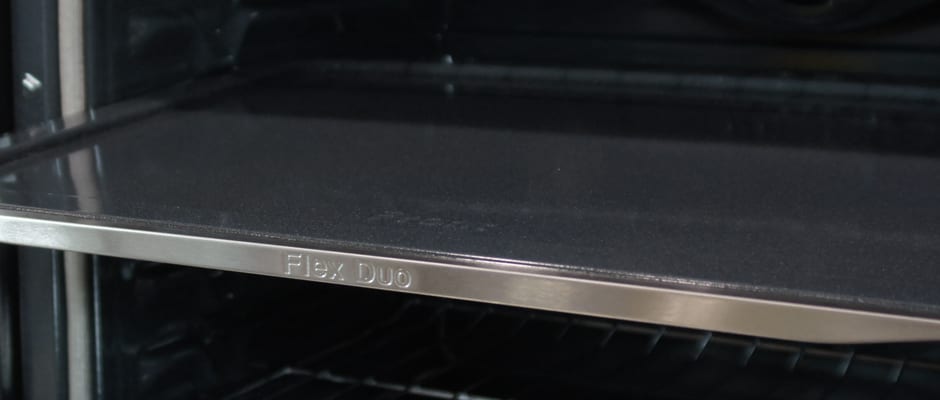Introduction
Samsung's Flex Duo system allows a user to split the oven with a ceramic divider to create two separately controllable cooking cavities, complete with their own convection features. Besides its namesake, the Flex Duo sports a litany of other features in its arsenal, which range from useful to simply...well, present.
Fortunately, the vast amount of options on the Flex Duo are backed by solid and at times even excellent performance. The only Achilles' heels we found were the less-than-stellar broiler and the over-powered front left burner. But this appliance has two ovens in one. It already wins.
If you've hit middle age and you're looking for a convertible, few will heat things up faster than this one. And let's face it: This is way more practical (and economical) than a Porsche.
Design & Usability
{{section_header}}{{section.name}}{{/section_header}}
This constitutes a whole new take on dual oven design.
The {{product.name}} is a unique beast: a single oven that can maintain two distinct temperatures. The trick is a lightweight divider that bisects the oven cavity. Slide it in, and the control panel changes to reflect the oven's newfound dual citizenship with displays for upper and lower oven temperatures. When you want to use the entire cavity, the divider stores in a slot above the warming drawer. Aside from this major feature, it's a traditional-looking, upscale, 30" freestanding range with rear controls (ugh) and stainless trim alongside black porcelain enamel.
The ceramic range sports four main burners and a 100W warming zone. The two front power burners have multiple elements to accommodate different sized pots, with two elements on the left and three on the right. Toward the middle of the cooktop, the 100W warming zone provides easy-bake power, and also keeps food warm before serving.
In addition to the {{product.name}}'s convertible nature, there are some equally unusual features. The control panel offers "Easy Cook," for example, which displays preset options for pizza, casserole, chicken nuggets, and cake. As well as making slightly offensive assumptions about the average American diet, this setting does not seem particularly useful, especially since most of these preset items call for a single oven temperature. More convenient are the "Custom Cook" options that allow the user to save temperature settings for frequently used recipes.
Three racks and seven rack settings allow for exceptional flexibility in conjunction with the Flex Duo divider, and with the various convection settings delivering even heat around the oven, the need to swap racks to prevent overcooking should be minimized.
{{photo_gallery "Vanity", "Front Photo", "Rangetop Controls Photo", "Oven Controls Photo", "Burners 1 Photo", "Burners 2 Photo", "Burners Cleaning Photo", "Upper Oven Photo", "Upper Oven Detail Photo", "Oven Detail Photo", "Lower Oven Detail Photo", "Lower Oven Photo", "Drawer Photo", "Broiler Photo",}}
Rangetop
{{section_header}}{{section.name}}{{/section_header}}
Though a bit of an afterthought next to everything else, this rangetop is excellent.
Samsung clearly put a good deal of resources into designing this rangetop. In our boiling tests, we found excellent results, with one burner especially rising among the rest for a very fast boiling time. We all know what they say about a watched pot, but this appliance eliminates some of that tedium. The elements also managed to put out a wide range of satisfactory temperatures, from searing to simmering.
Of course, the downside of having a delicate electric ceramic rangetop is the loss of precision, as there isn't any visual feedback from a flame when adjusting temperatures. Also, if you don't follow the cleaning directions listed in the manual, you run the risk of scratching the delicate surface.
Oven Broiler & Convection
{{section_header}}{{section.name}}{{/section_header}}
As long as you use either the convection fan or the divider, you'll get some of the best results money can buy.
This interesting oven had interesting test results. Despite the unimpressive 350°F and 550°F conventional settings, the convection oven had about the most consistent temperature control we've ever seen, hardly wavering from its 350°F target. In a similar vein of excellence, the divided oven did an amazing job on conventional mode, so don't worry, you've still got a good conventional oven. But the best part is that with the divider, both oven cavities have their own convection fans, so you can get this extraordinarily even performance twice in one product. It's worth mentioning that the upstairs oven can only operate on convection when the divider is in, though.
Unfortunately, despite the excellent oven performance, the broiler timed out in its tests; if you're big on broiling, this isn't the range for you. But still, depending on your cooking style, it's a little flaw on a big diamond. All in all, as long as you typically use either the convection fan or the divider, this oven is spectacular.
After the feast, it's time to clean. In addition to the traditional pyrolitic system, which burns all spills until they become charcoal, the {{product.name}} also features a steam cleaning option for lighter messes. It only takes 20 minutes, though it's definitely not as thorough as a full-on scrubbing. Moreover, the cooktop itself must be cleaned with a special solution, or it will permanently scratch.
Conclusion
{{section_header}}{{section.name}}{{/section_header}}
This is a well executed, innovative appliance.
The {{product.name}} may sound like a gimmick, marketing itself as the perfect blend of dual and single oven systems, yet it's anything but. This appliance skillfully avoids the trap of multifunction products: jack of all trades, master of none.
The Flex Duo breaks from the paradigm. As a single oven, with the divider safely secured in the storage/warming drawer, this appliance shows incredible temperature consistency in addition to a fast preheat. With the divider in place, the smaller cavities heat up quickly, and the temperature regulation is excellent.
The range, while less praiseworthy, also performed well in our tests, quickly boiling water on all of its burners—even the back burners that were designed more for simmering. The power of the front left burner did leave us a little nervous, but regardless of how hot things get, no one should be leaving an active stove unattended anyway.
Despite a few hiccups, this oven is a fine choice for people who want flexibility of size and multiple ovens without sacrificing performance. If it's in your price range, this is a fine choice.
Science Introduction
{{section_header}}{{section.name}}{{/section_header}}
Naturally, we make our lab test results available to you, dear reader. If you don't want us to hold your hand and digest the data for you, you can do it yourself right here.
Over Performance
{{section_header}}{{section.name}}{{/section_header}}
Samsung aced the range tests with lightning-fast preheats and consistent temperatures.
We often see ovens with a "keep warm" setting of 200°F, but we would prefer one around 170°F. Turns out, the folks at Samsung agree, with this oven hovering around our definition of warm—it's too hot for bacterial growth, but not so hot that it continues cooking food to a significant degree.
Then, though the {{product.name}}'s 350°F conventional oven exhibited a variance window of an unimpressive 47°F, we did see something we liked: the convection oven. Set to 350°F, the convection oven averaged 346°F and only went 7°F above and 5°F below that average. This is unbelievably great temperature control, and we hope other ranges take notice. The divided cavity had similar results: set to 425°F, the oven hit 426°F and stayed shockingly close. Because of this, we recommend using the divider whenever possible, as the top cavity with the convection mode activated seems superior than the whole oven on conventional mode. On the upper end of its capabilities, this oven averaged 525°F, though it was set to 550°F and couldn't keep still around its average. Divided (or on convection), this oven conquers.
{{photo_gallery "Science Section 1 Images"}}
Rangetop Performance
{{section_header}}{{section.name}}{{/section_header}}
On this appliance, you get solid boiling and simmering, though it runs a little too hot.
The front right triple-element power burners boiled very quickly, rolling six cups of water in four minutes 38 seconds—the same time it takes to listen to Misty Mountain Hop. If you're in the mood for Mozart, the front left dual-element burner will be boiling when you finish the 7.5-minute Molto Allegro. The back burners are back burners, and should be used accordingly. But if you must use them to boil, you'll be pleased to know it'll only take 12 minutes. Not great, but it's still faster than Frampton.
While the burners sure do run hot, this thing can simmer down when it needs to. Two of the burners delivered temperatures as low as 106°F, with the coolest running at 101°F. The fourth didn't do so hot either—and we mean that in the best way possible—showing us a very respectable 121°F. These excellent simmering temperatures often come in handy for keeping things warm, melting chocolate or butter without a double boiler, or simmering sauces.
The {{product.name}} has a bit of a temper, with two burners running the risk of actually getting too hot. The front left burner managed to heat our sensor to 823°F, a hellish temperature, and far too hot for safe use. This is far enough above the flash points of kitchen oils that it approaches their autoignition temperatures; a piece of pine, for instance, will spontaneously ignite above 800°F. Operate with care and consider locking out the upper ends of both left burners. The right burners, while cooler and safer to use, are plenty hot enough to sear and brown. Fortunately this means that this range doesn't need to work hard at all on medium settings, like a Ferrari driving at the speed limit.
{{photo_gallery "Science Section 2 Images"}}
Meet the tester
Ethan writes reviews and articles about science for Reviewed.com, and edits the Science Blog. He's originally from Vermont and thinks the bicycle and guitar are examples of perfected technology. Prior to Reviewed.com, he studied furiously at Middlebury College.
Checking our work.
Our team is here for one purpose: to help you buy the best stuff and love what you own. Our writers, editors, and lab technicians obsess over the products we cover to make sure you're confident and satisfied. Have a different opinion about something we recommend? Email us and we'll compare notes.
Shoot us an email




